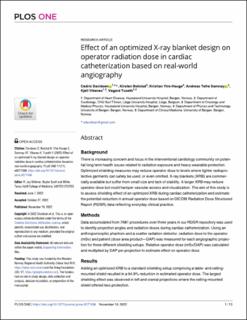| dc.contributor.author | Davidsen, Cedric | |
| dc.contributor.author | Bolstad, Kirsten Hansine Helene Nygaard | |
| dc.contributor.author | Ytre-Hauge, Kristian Smeland | |
| dc.contributor.author | Samnøy, Andreas Tefre | |
| dc.contributor.author | Vikenes, Kjell | |
| dc.contributor.author | Tuseth, Vegard | |
| dc.date.accessioned | 2023-01-17T10:30:26Z | |
| dc.date.available | 2023-01-17T10:30:26Z | |
| dc.date.created | 2022-12-05T09:20:47Z | |
| dc.date.issued | 2022 | |
| dc.identifier.issn | 1932-6203 | |
| dc.identifier.uri | https://hdl.handle.net/11250/3043948 | |
| dc.description.abstract | Background
There is increasing concern and focus in the interventional cardiology community on potential long term health issues related to radiation exposure and heavy wearable protection. Optimized shielding measures may reduce operator dose to levels where lighter radioprotective garments can safely be used, or even omitted. X-ray blankets (XRB) are commercially available but suffer from small size and lack of stability. A larger XRB may reduce operator dose but could hamper vascular access and visualization. The aim of this study is to assess shielding effect of an optimized XRB during cardiac catheterization and estimate the potential reduction in annual operator dose based on DICOM Radiation Dose Structured Report (RDSR) data reflecting everyday clinical practice.
Methods
Data accumulated from 7681 procedures over three years in our RDSR repository was used to identify projection angles and radiation doses during cardiac catheterization. Using an anthropomorphic phantom and a scatter radiation detector, radiation dose to the operator (mSv) and patient (dose area product—DAP) was measured for each angiographic projection for three different shielding setups. Relative operator dose (mSv/DAP) was calculated and multiplied by DAP per projection to estimate effect on operator dose.
Results
Adding an optimized XRB to a standard shielding setup comprising a table- and ceiling-mounted shield resulted in a 94.9% reduction in estimated operator dose. The largest shielding effect was observed in left and cranial projections where the ceiling-mounted shield offered less protection.
Conclusions
An optimized XRB is a simple shielding measure that has the potential to reduce operator dose. | en_US |
| dc.language.iso | eng | en_US |
| dc.publisher | PLOS | en_US |
| dc.rights | Navngivelse 4.0 Internasjonal | * |
| dc.rights.uri | http://creativecommons.org/licenses/by/4.0/deed.no | * |
| dc.title | Effect of an optimized X-ray blanket design on operator radiation dose in cardiac catheterization based on real-world angiography | en_US |
| dc.type | Journal article | en_US |
| dc.type | Peer reviewed | en_US |
| dc.description.version | publishedVersion | en_US |
| dc.rights.holder | Copyright 2022 The Author(s) | en_US |
| dc.source.articlenumber | e0277436 | en_US |
| cristin.ispublished | true | |
| cristin.fulltext | original | |
| cristin.qualitycode | 1 | |
| dc.identifier.doi | 10.1371/journal.pone.0277436 | |
| dc.identifier.cristin | 2088445 | |
| dc.source.journal | PLOS ONE | en_US |
| dc.identifier.citation | PLOS ONE. 2022, 17 (11), e0277436. | en_US |
| dc.source.volume | 17 | en_US |
| dc.source.issue | 11 | en_US |

